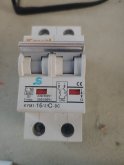Just had this question pop up on another thread.
What are the advantages/disadvantages of a double pole breaker compared to a single pole breaker for use in our systems.
I have been using double pole breakers because 3 years ago when I searched DC breakers that's what popped up.
What are the advantages/disadvantages of a double pole breaker compared to a single pole breaker for use in our systems.
I have been using double pole breakers because 3 years ago when I searched DC breakers that's what popped up.



